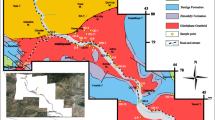Abstract
Fifteen bottled mineral waters purchased at random all over Turkey were analyzed for their chemical composition by OPTIMA-2000 ICP-AES Perkin Elmer techniques. Results show a wide spread in the chemical specification of these mineral waters, with differences in chemical composition observed in the regions being due to the geological environment and the majority of bottled mineral waters exceeding the pH limit of Turkish drinking water standards. When the concentrations of elements are evaluated, it can readily be seen that generally there are three types of mineral water in Turkey. The concentrations of Al, B, Ba, Cd, Cu, Cr, Fe, Mn Pb and Zn in mineral water were compared with the limits established by the Turkish Standard for Natural Mineral Waters (Turkish Official Gazette 2004); water standards prepared by World Health Organization (2006) and the United States of America Environmental Protection Agency (US EPA) drinking water standards (1993). Such a comparison shows that, except for Ba and Mn, the concentrations of the other heavy metals are lower than the limit of the US.EPA in Turkey. Some parameters examined were found to comprise strong correlations pair-wise.
Similar content being viewed by others
References
APHA (1992). Standard methods for the examination of water and wastewater. In A. E. Greenberg, L. S. Clesceri, & A. D. Eaton (Eds.), U.S. American Public Health Association, American Water Works Association and Water Pollution Control Federation, 18th ed. (pp. 1–13). Washington, DC.
Blackburn, B. G., Craun, G. F., Yoder, J. S., Hill, V., Calderon, R. L., Chen, N., et al. (2004). Surveillance for waterborne-disease outbreaks associated with drinking water—United States, 2001–2002. MMWR, 53(SS-8), 23–45.
Buor, D. (2004). Water needs and women’s health in the Kumasi metropolitan area, Ghana. Health and Place, 10, 85–103.
Burton, A. C., & Cornhill, F. (1977). Correlation of cancer death rates with altitude and with the quality of water supply of 100 largest cities in the United States. Journal of Toxicology and Environmental Health, 3, 465–478.
Burton, A. C., Cornhill, J. F. & Canham, B. (1980). Protection from cancer by ‘Silica’ in the water supply of U. S. cities. Journal of Environmental Pathology and Toxicology, 4, 31–40
Chapelle, F. H. (2003). Geochemistry of groundwater. In H. D., Holland & K. K., Turekian (Eds.), Treatise on geochemistry, vol. 5, pp. 425–449. Elsevier.
Codex Alimentarius Commission (1997). Standard for natural mineral waters. Rome, Food and Agriculture Organization of the United Nations and World Health Organization (CODEX STAN 108). Available at ftp://ftp.fao.org/codex/standard/en/CXS_108e.pdf.
Deutsch, W. J. (1997). Groundwater geochemistry, fundamentals and applications to contamination. Boca Raton: Lewis, p. 221.
Edmunds, W. M. & Smedley, P. L. (1996). Groundwater chemistry and health: an overview. In J. D. Appleton, R. Fuge, G. I. H. McCall (Eds.), Environmental geochemistry and health. Geological Society Special Publication, 113, 91–105.
Epstein, S. S., & Zavon, M. (1974). Is there a threshold for cancer? In D. X. Manners (Ed.), Water, Its Effects on Life Quality, International Water Quality Symposium (pp. 54–62). Washington, D. C.: Water Quality Research Council.
Hem, J. D. (1978). Study and interpretation of the chemical characteristics of natural water, US Geological Survey, 2nd edition. Washington: US Government Printing Office, p. 362.
Kara, E., Özdilek, H. G., & Kara, E. E. (2004). An investigation on physical, chemical, and bacteriological quality of municipally supplied and well waters of the towns and city centre in the province of Niðde, Turkey. International Journal of Environmental Health Research, 14(2), 151–156.
Lee, S. H., Levy, D. A., Craun, G. F., Beach, M. J., & Calderon, R. L. (2002). Surveillance for waterborne-disease outbreaks in the United States, 1999–2000. MMWR, 51(SS-8), 1−49
Malini, S., Nagaiah, N., Paramesh, L., Venkataramaiah, P., & Balasubramanian, A. (2003). Groundwater quality around Mysore, Karnataka, India. International Journal of Environmental Studies, 60, 87–98.
Misund, A., Frengstad, B., Siewers, U., & Reimann, C. (1999). Variation of 66 elements in European bottled mineral waters. The Science of the Total Environment, 243–244, 21–41.
Nkhuwa, D. C. W. (2003). Human activities and threats of chronic epidemics in a fragile geologic environment. Physics and Chemistry of the Earth, 28, 1139–1145.
Panapitikkul, N., Pengnoo, A., Siriwong, C., & Chatupote, W. (2005). Hydrogeomorphological controls on groundwater quality in the Rattaphum catchment (Songkhla Lake basin), Thailand. Water, Air and Soil Pollution: Focus, 5, 149–163.
Reimann, C., & de Caritat, P. (1998). Chemical elements in the environment-factsheets for the geochemist and environmental scientist. Berlin-Heidelberg-New York: Springer, p. 398.
Samek, K. (2004). Unknown quantity: The bottled water industry and Florida’s springs. Journal of Land Use. 19(2) Spring 569–595.
Turkish Official Gazette (2004). Directive on natural mineral waters. December 1, 2004 No: 25657.
Turkish Official Gazette (2005). Directive on environmental quality of surface water resources that are currently under operation or planned to be used in the future. November 11, 2005 No: 25999.
US EPA (1993). Standard methods for the examination of water and wastewater, Environmental Protection Agency (EPA). US: American Publish Health Association.
WHO (2006). Guidelines for drinking-water quality. First Addendum to Third Edition. Volume 1, Recommendations. Geneva, Switzerland: WHO, pp. 595.
Author information
Authors and Affiliations
Corresponding author
Rights and permissions
About this article
Cite this article
Baba, A., Ereeş, F.S., Hıçsönmez, Ü. et al. An assessment of the quality of various bottled mineral water marketed in Turkey. Environ Monit Assess 139, 277–285 (2008). https://doi.org/10.1007/s10661-007-9833-9
Received:
Accepted:
Published:
Issue Date:
DOI: https://doi.org/10.1007/s10661-007-9833-9




